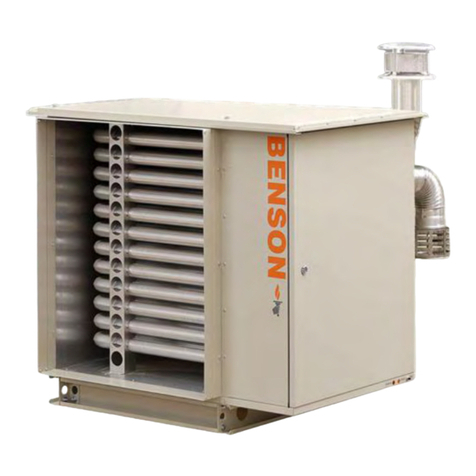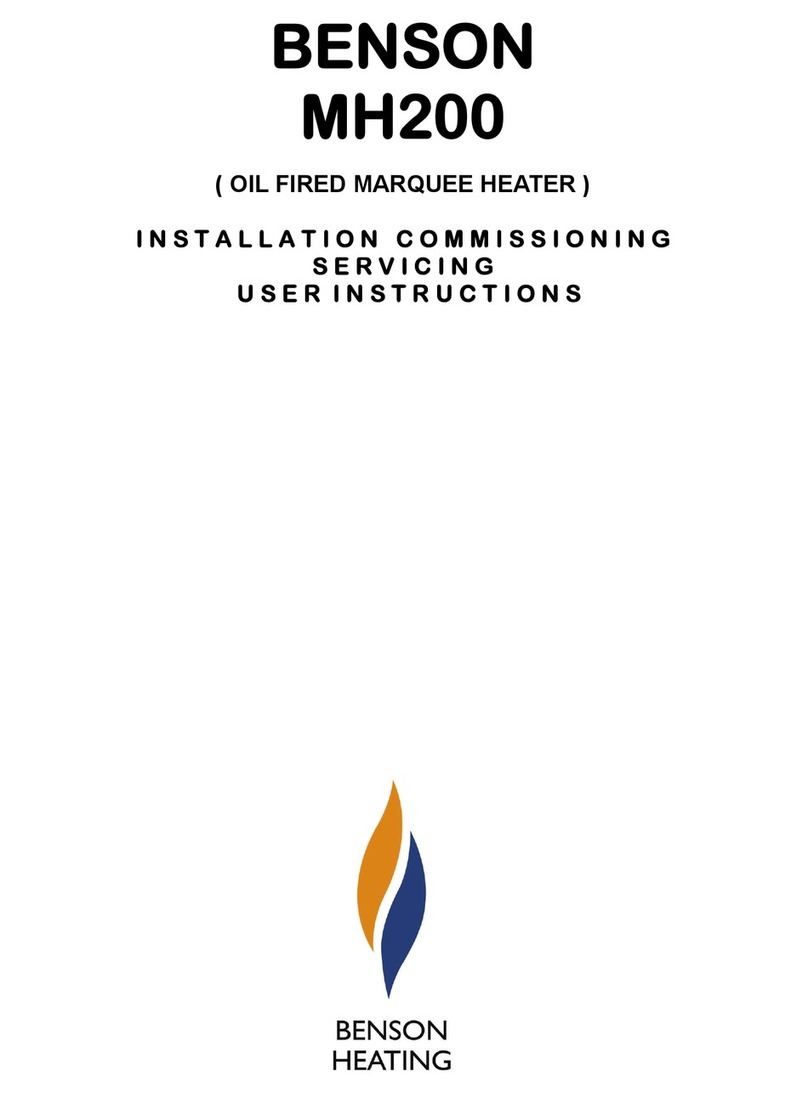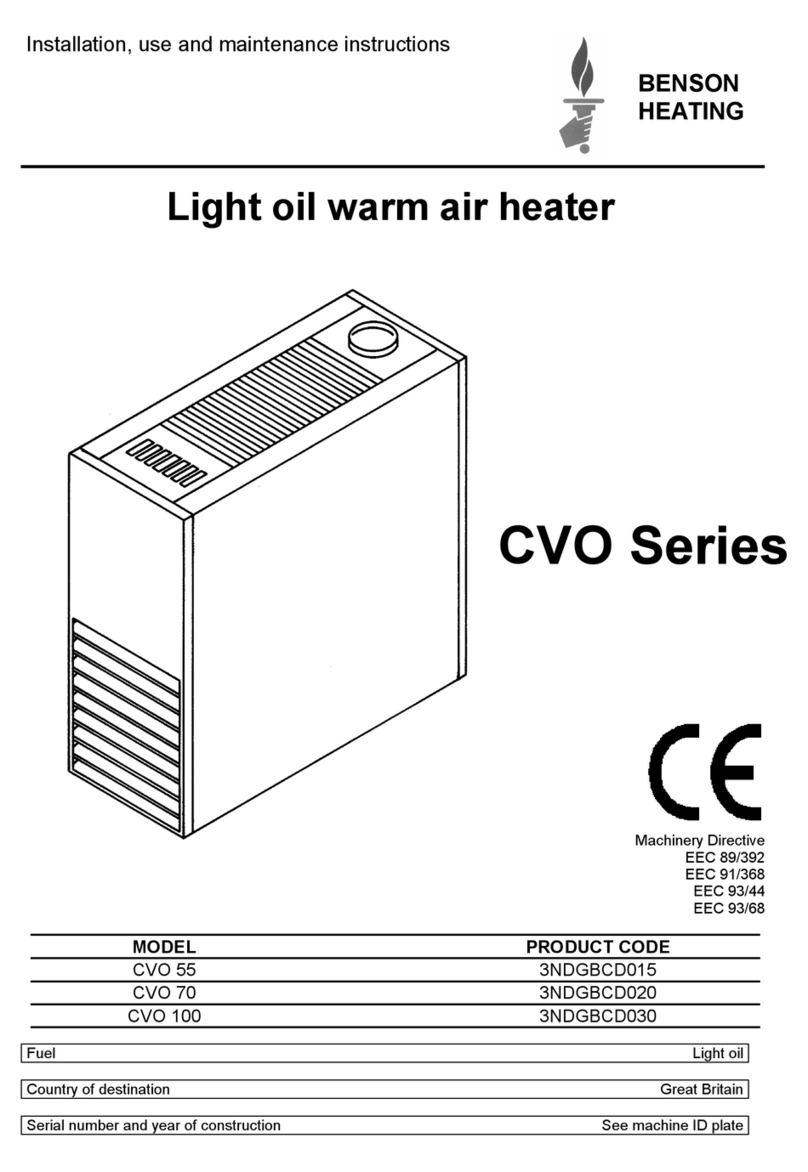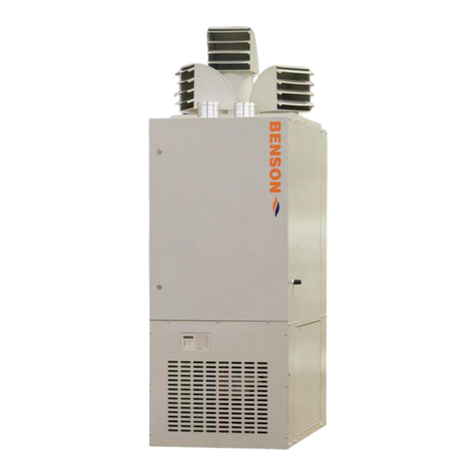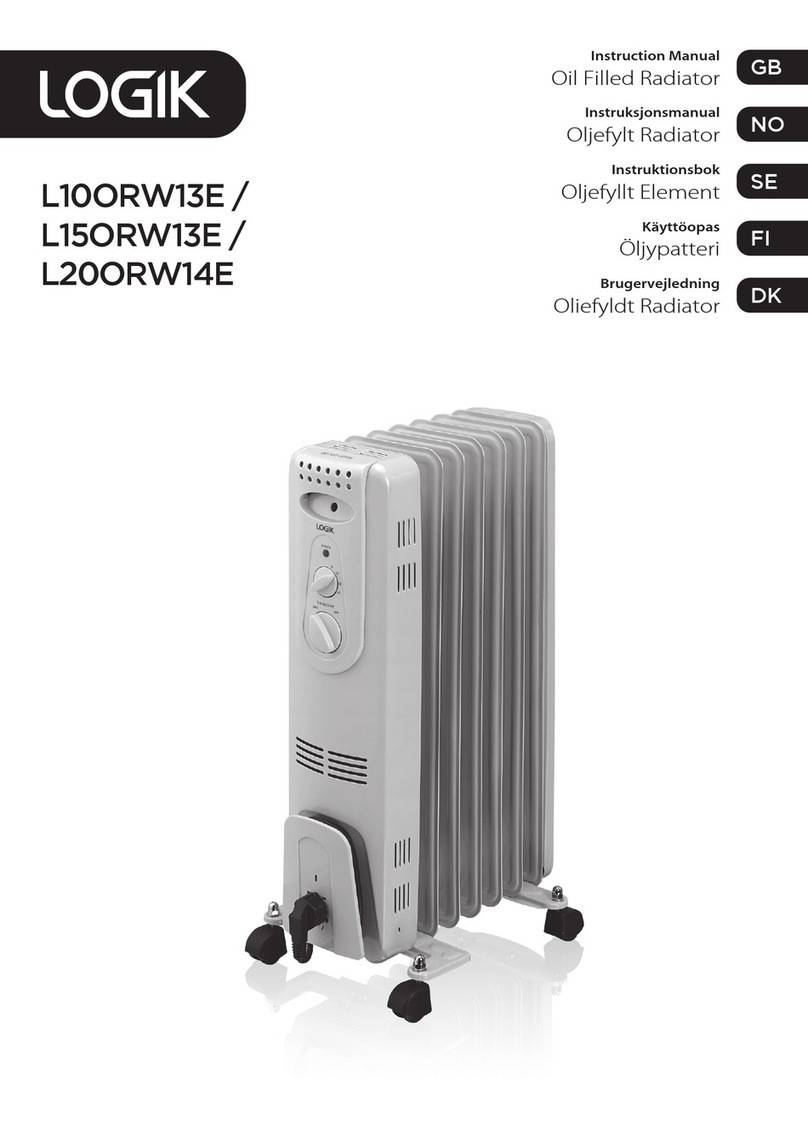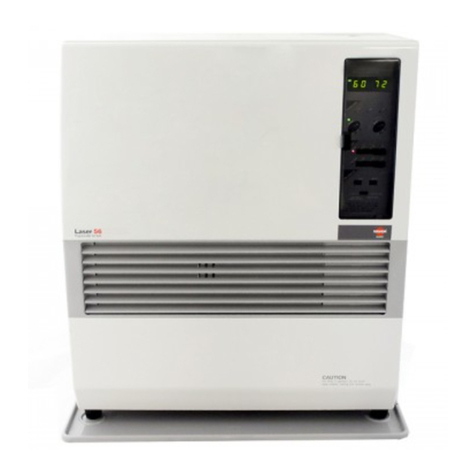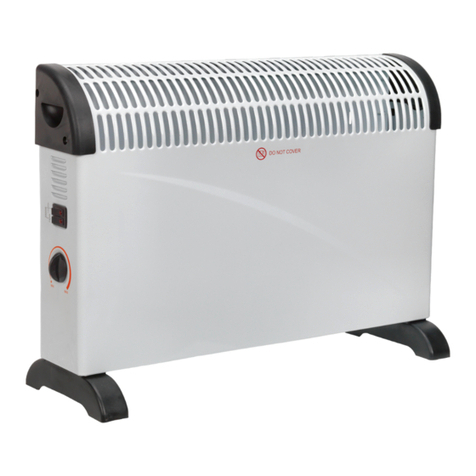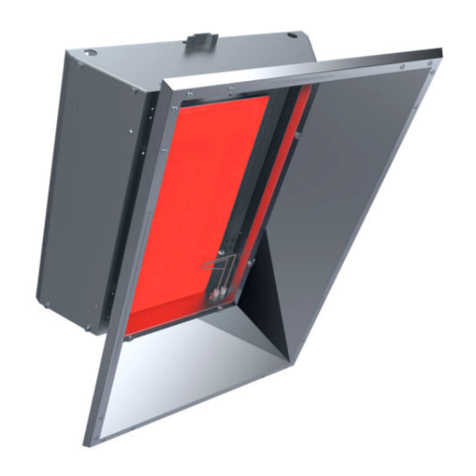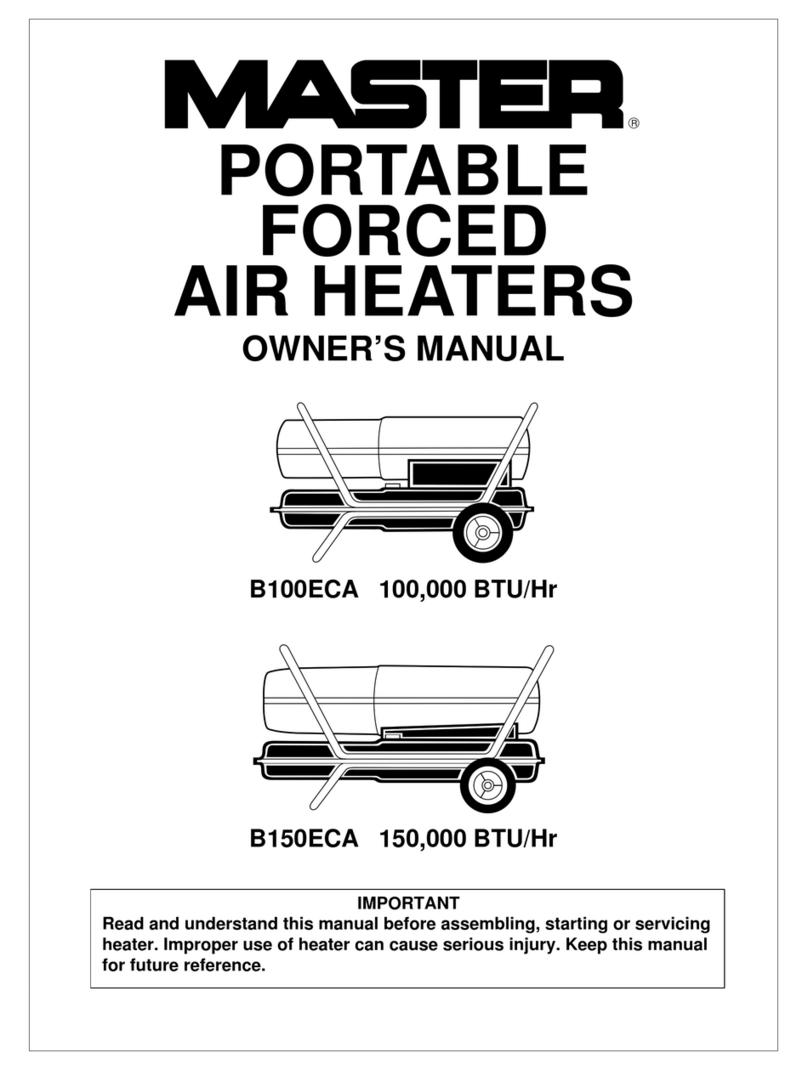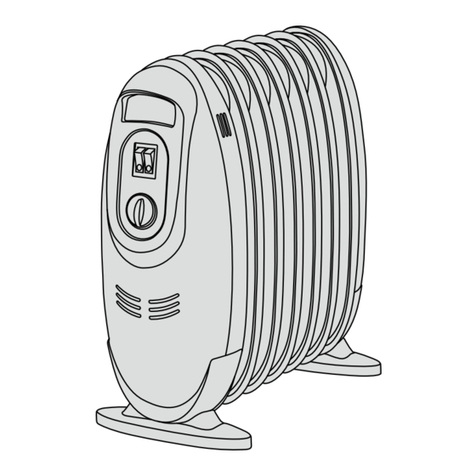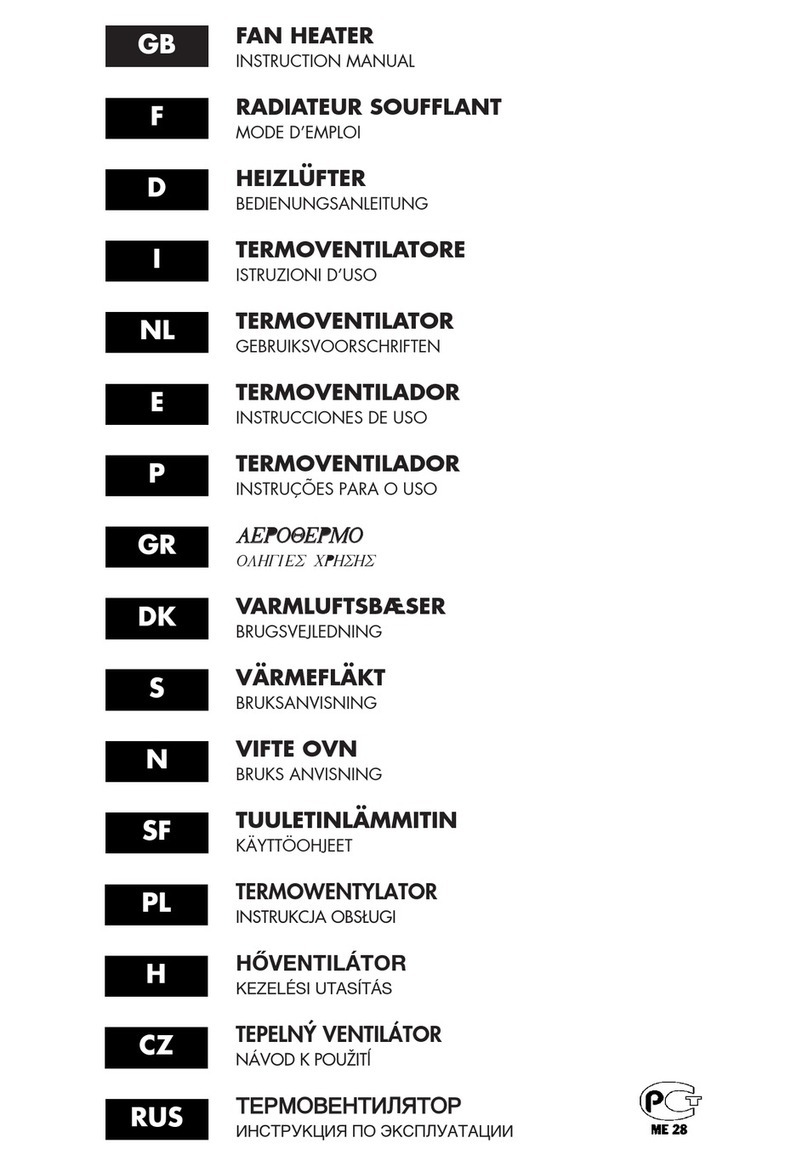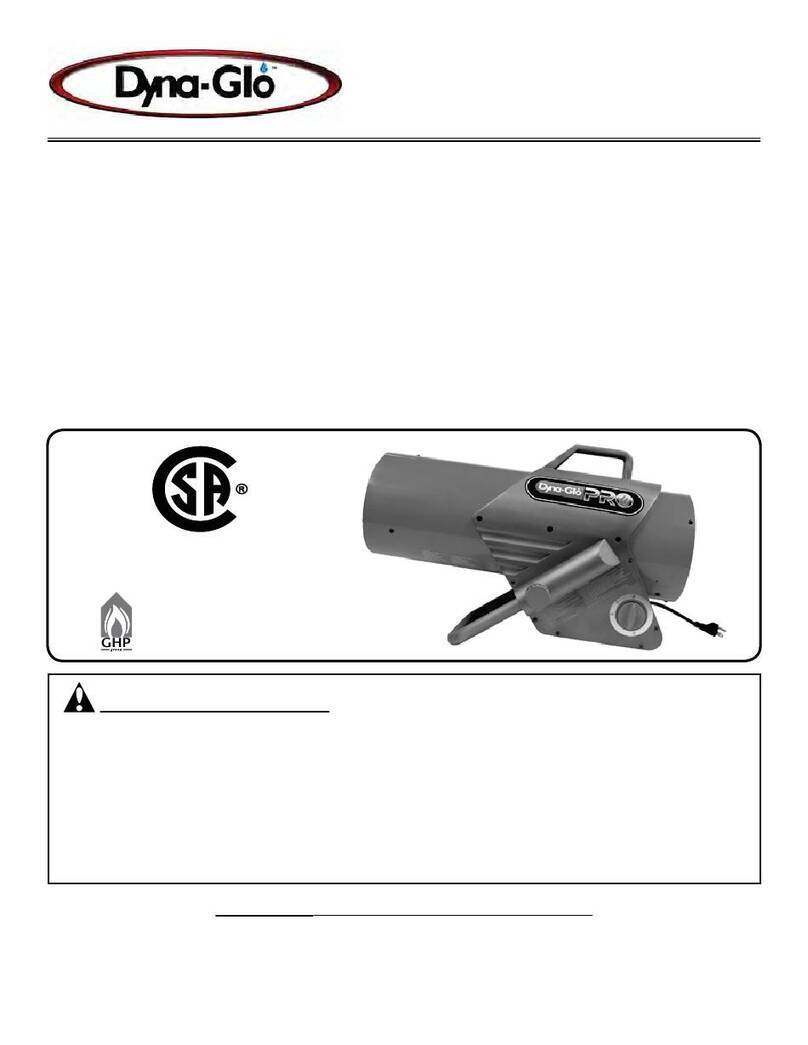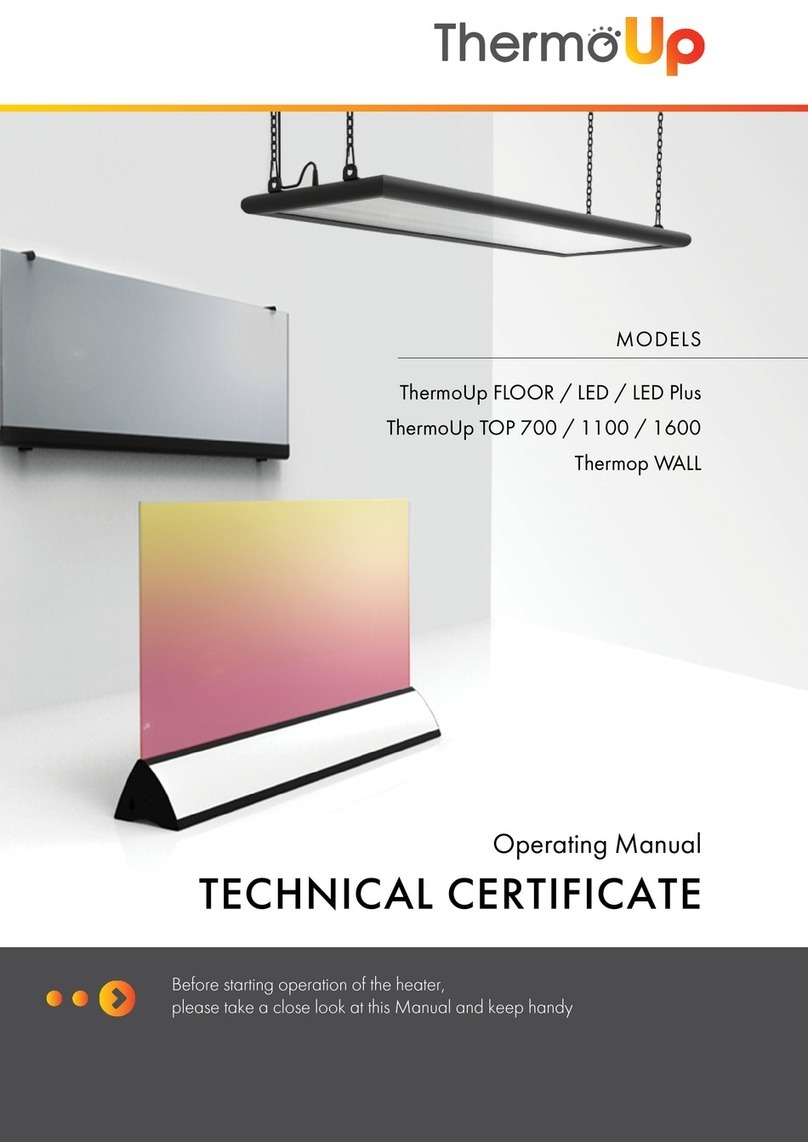BENSON HEATING GUH100 Installation instructions

GUH RANGE PROPANE GAS FIRED UNIT HEATERS
Page 1 of 41
BENSON GUHA/GUHC
RANGE
(PROPANE GAS FIRED UNIT HEATER)
I N S T A L L A T I O N C O M M I S S I O N I N G
S E R V I C I N G
U S E R I N S T R U C T I O N S
October 2002
(Issue 3)

GUH RANGE PROPANE GAS FIRED UNIT HEATERS
Page 2 of 41
~ C O N T E N T S ~
S E C T I O N A
1.0 Compliance Notices
1.1 Certificates of Conformity
1.2 General Product Information
1.3 General Requirements
1.4 Delivery & Pre-installation Checks
1.5 Warranty
2.0 Installation
2.1 Installation Clearances and Mounting Heights
2.2 Heater Mounting
2.3 Warm Air Circulation
2.4 Air Supply
2.5 Flue Installation
2.6 Electrical Installation
2.7 Electrical Panel
2.8 Time Switch
2.9 Room Thermostat
2.10 Fan and Limit Controls
2.11 Summer / Ventilation Switch
2.12 Gas Installation
3.0 Commissioning
3.1 Electrical Pre-Tests
3.2 Gas Supply Pre-Tests
3.3 Ignition Sequence Manual Versions
3.4 Ignition Sequence Automatic Versions
3.5 Hand Over
4.0 Servicing
4.1 Servicing Procedure
5.0 Fault Diagnosis by Flow Charts
6.0 Wiring Diagrams
7.0 Technical Data Formulae
7.1 Technical Data Common Information
7.2 Technical Data Heater Information
8.0 Reference Information
9.0 Parts Listing

GUH RANGE PROPANE GAS FIRED UNIT HEATERS
Page 3 of 41
S E C T I O N B
Warranty Registration
Updated Information
Timer Information Manual
S E C T I O N C
10.0 Introduction
10.1 Commissioning / Hand over
10.2 Servicing
10.3 Start up Procedure
10.4 Start up Procedure Automatic Versions
10.5 Stop Procedure Manual / Automatic Versions
10.6 Shut Down Procedure
10.7 Fail-safe Situations
10.8 Contact Information
I L L U S T R A T I O N S
Fig 1 Exploded view
Fig 2 - 12 Flue Systems
0Fig 13 - 14 Gas Train & Pilot Installation
Fig 15 - 16 Electrical Installation
Fig 17 - 18 Axial & Centrifugal Fans
Fig 19 - 27 Fault Diagnosis Flow Charts
Fig 28 - 35 Electrical Drawings
Fig 36 Main Dimensions
Any reference made to Laws, Standards, Directives , Codes of Practice or other recommendations
governing the application and installation of heating appliances and which may be referred to in
Brochures, Specifications, Quotations, and Installation, Operation and Maintenance manuals is done so
for information and guidance purposes only and should only be considered valid at the time of the
publication. Benson Heating cannot be held responsible from any matters arising from the revision to or
introduction of new Laws, Standards, Directives, Codes of Practice or other recommendations.

GUH RANGE PROPANE GAS FIRED UNIT HEATERS
Page 4 of 41
1.0 Compliance notices
The Benson GUH range of warm air heaters detailed herewith are manufactured by Benson Heating
within a strictly controlled environment within the parameters of ISO9001
The Benson GUH Range has been independently tested and assessed, and has been found to meet the
Essential Requirements of the following European Directives.
Gas Appliance Directive (90 / 396 / EEC)
Machinery Directive (89 / 392 EEC)
Low Voltage Directive(73 / 23 / EEC & 93 / 68 / EEC)
Electromagnetic Compatibility Directive (98 / 336 / EEC & 91 / 31 / EEC)
Product Liability Directive 65 / 374 / EEC)
The manufacturer has taken reasonable and practical steps to ensure that Benson GUH Range of Heaters
are safe and without risk when properly used. These heaters should therefore only be used in the manner
and purpose for which they were intended, and in accordance with the recommendations detailed
herewith.
The heaters have been designed, manufactured, assembled, inspected, and tested, with safety and quality
in mind, there are certain basic precautions which the installer and user should be aware of, and they are
strongly advised to read the appropriate sections of the information pack accompanying the heater, prior
to installation or use.
Benson Heating supports all new products being supplied to their customers with a comprehensive
information pack; this clearly defines mandatory instructions for the safe installation, use, and
maintenance, of the appliance(s).
Where proprietary items are incorporated into Benson Heating products, detailed information and
instructions are also provided as part of the information pack.
It is the responsibility of the installer, owner, user, or hirer, of such products supplied by Benson Heating,
to ensure that they are familiar with the appropriate information/manuals, supplied by the manufacturer,
and that they are suitably aware of the purpose of the manuals and the safety instructions. In addition,
operators must be suitably trained in the use of the appliance so as to ensure its continued safe and
efficient use.
Benson Heating has a commitment to continuous improvement, and therefore reserves the right to amend
or change the specification of the GUH Heater range subject to agreement from The Notified Body.
Contained within the text of the manual, the words 'Caution' and 'Warning' are used to highlight certain
points.
Caution is used when failure to follow or implement the instruction(s) can lead to premature failure or
damage to the heater or its component parts.
Warning is used when failure to heed or implement the instruction(s) can lead to not only component
damage, but also to a hazardous situation being created where there is a risk of personal injury.

GUH RANGE PROPANE GAS FIRED UNIT HEATERS
Page 5 of 41
The Benson GUH range of heaters conform to the following European Harmonised Standards.
BS EN 621 1998 Requirements for non domestic gas fired forced convection air heaters for space heating
without a fan to assist transportation of combustion air and/or combustion products.
BS EN 292 - Part 1 : 1991
Safety of Machinery - Basic Concepts, General Principles for Design
Basic terminology, methodology
BS EN 292 - Part 2 : 1991
Safety of Machinery - Basic Concepts, General Principles for Design
Technical Principles and Specifications
BS EN 60204 - Part 1 : 1993
Safety of Machinery - Electrical Equipment for Machines
Specification for General Requirements
BS EN 60335 - Part 1 : 1988
Safety of Household and Similar Electrical Appliances
General Requirements
BS EN 55014 - 1993
Limits and methods of measurement of radio disturbance characteristics of electrical motor-
operated and thermal appliances for household and similar purposes, electrical tools and
similar electric apparatus
BS EN 50165 - 1995
Electrical Equipment of non-electric heating appliances for household and similar purposes,
safety requirements
1.1 Certificates of conformity
Declarations and Certificates are available upon request from the Quality Control Department at Benson
Heating .
Notified Body PIN Reference is 63AQ0533
1.2 General product information
The Benson GUH Range have an output rated at between 29.3kW to 73.3kW, and 117.3kW are available
with either axial or centrifugal fans
The Model Range is made up as follows;
Each heater must be connected to its own individual open flue in accordance with the manufactures
recommendations.
MODEL 100 125 165 205 250 400
OUTPUT 29.3 37.0 48.4 61.6 73.3 117.3

GUH RANGE PROPANE GAS FIRED UNIT HEATERS
Page 6 of 41
Cabinet
Manufactured from zintec coated steel, finished in a durable stove enameled polyester powder
paint.
Heat Exchanger
Manufactured from aluzinc coated steel, and formed from pressed and welded sections into a
multiple clam assembly.
Flue Outlet
Fabricated from aluzinc coated steel . The part is designed to terminate with a spigot . the
assembly incorporates the down draught diverter.
Burner
The atmospheric gas burner is manufactured from aluzinc coated steel and is located beneath the
clam. The complete burner rack is easily withdrawn through the front of the heater.
Standard heaters are supplied suitable for Propane Gas.
Burner Control
Models 100 – 250 & 400 heaters are fitted with a manually operated piezo spark igniter and low
consumption pilot, linked via an integral thermocouple to the main multifunctional valve.
An automatic facility is also available for all models within the range.
Fan
Models GUH (A) are supplied with an Axial fan for free blowing applications .
Models GUH (C) are supplied with Centrifugal fans suitable for ducted applications
Note
Neither asbestos nor soft soldered joints are used in the construction or manufacture of the Benson range
of GUH Heaters. The materials selected for use can withstand the mechanical, chemical, and thermal
stresses which they will be subject to during foreseen normal use when installed in accordance with the
manufacturers recommendations.
1.3 General requirements
Caution
Ensure that the gas service to the appliance carries the correct gas type and that the supply pressure is in
accordance with the supply type and pressure stated on the appliance data plate.
Installation, commissioning, and servicing must only be carried out by appropriately qualified and
competent persons.
Warning
Unauthorised modifications to the appliance, or departure from the manufacturers guidance on intended
use, or, installation contrary to the manufacturers recommendations may constitute a hazard.
Note
To ignore the warning and caution notices, and to ignore the advice from the manufacturer on
installation, commissioning, servicing, or use, will jeopardise any applicable warranty, moreover, such a
situation could also compromise the safe and efficient running of the appliance itself, and thereby
constitute a hazard.

GUH RANGE PROPANE GAS FIRED UNIT HEATERS
Page 7 of 41
The installation of the appliance must meet all the relevant European, National, and local criteria.
(See sections 2 and 8).
Prior to installation the following points should be considered;
a) The position of the heater for the optimum efficient distribution and circulation of warm air
b) The position of the heater relative to the route of the flue
c) The position of the heater relative to the supply of gas
d) The position of the heater relative to the electrical services, wiring routes, and if appropriate, any
additional controls.
e) The position of the heater relative to the supply of fresh air
f) The position of the heater relative to potential stratification / circulation problems, which generally
occur at higher levels and which may be overcome through the provision of a suitable de-stratification
unit.
g) The position of the heater relative to service and maintenance requirements
Caution
The heater must not be installed within an area where the conditions are unsuitable, e.g. where the
atmosphere is highly corrosive, has a high degree of salinity, or where high wind velocities may affect
burner operation. Suitable protection should be provided for the appliance when it is located in a position
where it may be susceptible to external mechanical damage from; for example, fork lift trucks, overhead
cranes etc.
1.4 Delivery and pre-installation checks
The heater is supplied wrapped in heavy duty protective polythene, mounted on a pallet.
On receipt of the heater, the following checks should be carried out;
a) The model is as per order
b) That it is undamaged
c) That it is suitable for the gas supply and pressure
d) That it is suitable for the electrical supply
If any of these points are not satisfied then contact should be made with the Sales Office at Benson
Heating as soon as possible by telephoning 01547-528534. In the case of claims for damage, this must be
reported in writing within 24 hours of delivery, in order to comply with insurance criteria

GUH RANGE PROPANE GAS FIRED UNIT HEATERS
Page 8 of 41
1.5 Warranty
The heater is supplied with a 1 year warranty on all parts except the thermocouple.
In addition to this there is also a 5 year time related warranty on the combustion chamber.
The warranty commences from the date of dispatch from the manufacturer, and is subject to the terms
detailed within the Benson Heating 'conditions of business'.
Note (i)
The warranty may be invalidated if -
a) The warranty registration/commissioning card has not been completed and returned to Benson Heating
b) The installation is not in accordance with the general requirements of this manual
c) The flue arrangement and air supply for the heater are not in accordance with the manufacturers
recommendations, codes of practice, or similar standards
d) Air flow through the heater is not in accordance with the manufacturers technical specifications
e) Internal wiring on the heater has been tampered with or unauthorised service/repairs undertaken
f) The main electrical supply input to the heater has been interrupted during the heating mode
g) The heater has been subject to and affected by the ingress of water in any form
h) The heater is not operated at the rating(s) laid down in the manufacturers technical specifications
i) The heater has not been operated or used within the normal scope of its intended application
j) The manufacturer's recommended minimum service requirements have not been complied with
Note (ii)
All warranty claims must contain the following information to enable processing to take place;
(1) Heater model
(2) Heater serial number
(3) Order reference/date of order, together with full installation details (name and address)
(4) Details or symptoms of fault
(5) Installers name and address.
Faulty parts must be returned to the Benson Heating Spares Department, the address of which is provided
on the cover of this manual. Any such parts will undergo inspection to verify the claim. Replacement
parts supplied prior to this may be charged, and a credit supplied upon subsequent validation of the
warranty claim.
Consumable items are specifically not included within the scope of the warranty.
Note (iii)
Notification is required immediately a fault is suspected.
The manufacturer will not accept responsibility for any additional damage that has been caused, expense
incurred, or consequential loss resulting from any failure of the heater(s).

GUH RANGE PROPANE GAS FIRED UNIT HEATERS
Page 9 of 41
2.0 Installation
Note
It is a requirement that only qualified and competent personnel may undertake installation
commissioning and servicing of GUH Range Heaters.
Warning
All of the basic criteria must be satisfied prior to commencing installation and commissioning,
additionally, the Unit Heater must be positioned and installed so as to comply with all the relevant
standards and guide lines (see section 8.0), as well as meeting national and local fire regulations and
insurance criteria, especially if it is proposed that the heater is to be installed within a special risk area
(e.g. proximity to where petrol engined vehicles are stored or parked, where cellulose spraying takes
place, where woodworking machinery is operated, etc,).
Indirect fired heaters must not be located in hazardous areas, however, it is permissible for the heater to
supply air to such areas. The heater must not be installed within an environment where there is a high
concentration of chlorides, fluorides, salts, or other aggressive or volatile chemicals/compounds.
Nor should the heater be positioned where the burner could be adversely affected by high winds or
draughts.
The heater must be installed so that it is level. Supports for the heater must be sufficiently robust to
withstand the weight of the heater and any ancillary equipment. Any combustible material adjacent to the
heater or flue system must be so placed or shielded so that its surface temperature does not exceed 65C
The location chosen for the heater must allow for the fitting of an effective flue system.
The location must also allow for adequate clearance for the air supply, return air circulation, oil supply,
electrical supply, whilst also providing good and safe working access.
The heater must be installed so that it is level, supports for the heater must be sufficiently robust to
withstand the weight of the heater and any ancillary equipment
Any combustible material adjacent to the heater or flue system must be so placed or shielded so that its
surface temperature does not exceed 65oC. Generally a free blowing heater should be located at a height
(measured from floor level to the base of unit) as detailed within section 2.1
The location chosen for the air heater must allow for the fitting of an effective flue system. It must also
allow adequate clearance for the air supply, return air circulation, gas supply, electrical supply and also
provide good service access.
Suspended free blowing Unit Heaters are at their most effective when located as close to the working
area as possible. However care should be exercised to avoid directing the discharged air directly onto the
occupants of the area to be heated.
Where the passage of cold air causes problems (eg by entrances, loading bays etc) it is considered
favourable if the heater is positioned so as the discharge towards or across the cold air source from a
distance from 1.5m - 6m dependent upon the size of the entrance and the air throw characteristics of the
heater. On exposed walls heaters should be positioned so as to discharge towards, or along the length of
the exposed wall.
In areas where it is proposed that more than one heater is to be installed, a general scheme of circulation
should be drawn up and maintained, thereby offering the best heat distribution. Air pressure within the
area heated and the outside air pressure must remain the same, factors influencing this would be the
presence of extraction systems, ventilation systems, and various types of process plant.
GUH (A) Heaters are only suitable for free blowing applications or where the duct length does not
exceed 2 metres.

GUH RANGE PROPANE GAS FIRED UNIT HEATERS
Page 10 of 41
In which case the cross- section of the duct must be at least the same as that of the heater discharge grille
Where the heater is positioned to discharge through a wall opening a clearance of 2 metres in front of the
unit is required to allow for the correct operation of the down draught diverter and access for servicing.
In such applications a stub duct should be fitted and sealed at the interface between the discharge grille
on the heater and the opening in the wall.
2.1 Installation Clearances and Mounting Heights
The Heater must be installed so as to provide the following clearances
FRONT REAR TOP LEFT RIGHT BASE
2000mm 500mm 200mm 500mm 500mm 250mm
The recommended maximum and minimum mounting heights in metres are as follows:
MODEL 100 125 165 205 250 400
Max 3.03 3.33 3.64 3.94 3.94 4.24
Min 2.12 2.42 2.73 2.73 2.73 2.73
Any combustible material adjacent to the air heater and / or flue system must be so placed or shielded so
as to ensure that its temperature does not exceed 65Deg C
2.2 Heater Mounting
The heater and flue must be adequately supported by one of the following methods ;
a) Suspension by steel drop rods or straps from the M12 fixing points located on top of the heater
These must be of sufficient strength to safely carry the weight of the unit and ancillary equipment. The
straps may only drop vertically to eyebolts, if used; I.E. They must not be joined to the eyebolt at an
angle to the vertical, and eyebolts if used should be of an approved type.
b) On specifically designed cantilever brackets mounted from a non-combustible wall.
c) On a level non-combustible surface capable of adequately supporting the weight of the unit and
ancillary equipment . Under these circumstances approved mounting feet must be fitted.
Note
GUH (C) Models cannot be supported on cantilever brackets.
2.3 Warm Air Circulation
The air heater should be positioned to enable maximum circulation of discharged warm air within the
area to be heated, whilst taking account of personnel within the area, sources of cold air ingress , and
obstructions.
The air temperature rise on passing the heat exchanger is typically around 34Deg C
A full and unobstructed return air path to the air heater must be provided (see 2.4 Air Supply).
Where the heater is positioned to deliver blown air through an opening in a wall, return air intakes should
be located so that they cannot become blocked. Similarly these intakes must be positioned so as not to
draw in odours, fumes, hazardous vapours or particles.
Barrier rails should be provided to eliminate the risk of combustible materials being placed within 1M of
the warm air outlet.

GUH RANGE PROPANE GAS FIRED UNIT HEATERS
Page 11 of 41
2.4 Air Supply
Provision must be made for the existence of an air supply in order to satisfy both combustion and
ventilation criteria.
It is a requirement that the area where the air heater is located must have a permanent air vent of
negligible resistance direct to the outside air.
Such air vents must be positioned so as not to become blocked or flooded, nor should they be placed so
as to introduce undesirable matter (e.g. flammable, volatile, or aggressive chemicals/compounds or
potentially hazardous or harmful substances) either direct from the outside, or through their proximity to
an adjacent extraction system.
The criteria necessary for establishing the minimum size of natural vents is detailed as follows;
Position of vent Area of vent direct to outside
Low level (<60kW) 9.0cm2per kW
Low level (>60kW) 540cm2 + 4,5cm2per kW of
(Inlet) rated input per heater
High level (<60kW) 4.5cm2per kW
High level (>60kW) 270cm2+ 2,25cm2per kW of
(Outlet) rated input per heater
Where mechanical ventilation is used it is a requirement that the inlet is of the mechanical type, and the
outlet is either mechanical or natural.
Caution
Systems of ventilation that employ mechanical extraction and natural inlet must not be used.
Furthermore, where the air supply is by way of a mechanical means the inlet must be positioned at low
level and be capable of providing a minimum throughput as detailed in section 7.2 of this manual.
The natural extraction air vents must have a minimum area as per the above table, and it is strongly
recommended that natural extraction vents are situated at high level.
Additionally, an automatic control interlocked to the burner must be fitted to ensure burner shutdown in
the event of airflow failure or restriction.
When the area to be heated already has an extraction system, the size of the air vent must be sized to
account for this and to maintain the required number of air changes
If the heater is to be installed within its own separate building or plant room, the above details do still
apply, as does the requirement for minimum space, further consideration should be made for free air for
recirculation to avoid the possibility of negative pressure in the plant room (see guidance notes below)
Additionally the maximum temperature within the plant room should not exceed 32DegC
Note
It is strongly recommended that BS 6230 : 1991 is referred to for further information concerning
ventilation requirements.

GUH RANGE PROPANE GAS FIRED UNIT HEATERS
Page 12 of 41

GUH RANGE PROPANE GAS FIRED UNIT HEATERS
Page 13 of 41
2.5 Flue Installation.
An integral flue spigot is fitted to all GUH Air Heaters thereby allowing the flue to connect directly to
the heater.
The design of the flue must ensure that it can be disconnected to allow for cleaning and servicing.
Further more all of the flue section joints must face upwards and the seal between the sections achieved
through the use of approved caulking string and / or grout.
Warning
It is essential that the products of combustion are flued to the outside of the building.
Each heater must have its own separate flue, with a flue diameter of not less than is detailed in section 7.2
within this manual.
The flue assembly must comply with all the relevant regulations regarding height and materials, and must
terminate with an approved flue terminal.
All GUH Air Heaters are equipped with a built in down draught diverter which prevents the recirculation
of combustion products, consequently an external draught diverter, barometric damper, or anti spillage
system must not be installed. Such devices are unnecessary on the GUH range of heaters.
Alterations to the built in down draught diverter must not be carried out, and it is necessary to provide a
minimum unobstructed clearance in front of the heater of 2Metres to ensure that the down draught
diverter will function correctly and also provide access for servicing.
In order to provide adequate natural draught, the minimum vertical length of flue must not be less than
2Metres.
The flue should rise vertically, and the number of bends should be kept to a minimum.
The temperature of the combustion products can be as high as 260° C and therefore tend to rise naturally
within the flue. Unnecessary bends and restrictions should therefore be avoided.
Provision for the disconnection of the flue for servicing and inspection purposes must also be made, and
where appropriate bends should be fitted with access covers, again to allow for cleaning and inspection.
The position of the flue and its terminal should be such that it does not impair the combustion process. It
should terminate in an exposed position so as to allow the free escape of flue gases without risk of their
re-entering the building through windows, ventilation ports etc.
The following illustrations of different flue configurations are included for guidance purposes (see
figures 2-12 )
If the flue does not have access to an existing chimney then it should be extended through the roof or
wall to a height of at least 1M above that of any object within 3.5M of the terminal.
The materials from which the flue is constructed must be non-combustible, resistant to internal and
external corrosion, and be capable of withstanding the stresses and loadings associated with normal use.
When designing the flue system the prevention of the formation and entrapment of condensation must be
a key consideration.
Twin wall or insulated systems are recommended, as they tend to inhibit the formation of condensates.
Where condensation is unavoidable traps should be included to encourage the condensates to flow freely
to a point from which they may be released, preferably into a gully.
The condensate pipe from the flue to the disposal point must be made from corrosion resistant pipe of not
less than 25mm internal diameter.
If the flue passes through a wall, ceiling, or roof made from combustible material then it has to be sleeved
so as to provide a minimum of a 25mm void between the exterior of the flue and the internal wall of the
sleeve.
The maximum permitted temperature of any adjacent combustible material is 65o C.

GUH RANGE PROPANE GAS FIRED UNIT HEATERS
Page 14 of 41
Caution
It is imperative that the flue should be properly sealed where it passes through the roof, this can best be
achieved by using the approved method of roof flashing plate and cravat.
The flue outlet on all GUH heaters can be in either vertical or horizontal (top or rear) configuration.
Note
It should be noted that claims made under warranty and attributed to the ingress of water may not be
considered especially if an approved method of sealing has not been used, or if the design of the flue has
not made provision for possible condensation problems.
Where a horizontal outlet is used, the manufacturer strongly recommends that a flue venter of an
approved type is fitted to aid the evacuation of the combustion products.
It is also recommended that BS5854: 1980 and BS5440: parts 1 and 2 are used as a consultative
document when considering flue requirements.

GUH RANGE PROPANE GAS FIRED UNIT HEATERS
Page 15 of 41

GUH RANGE PROPANE GAS FIRED UNIT HEATERS
Page 16 of 41

GUH RANGE PROPANE GAS FIRED UNIT HEATERS
Page 17 of 41

GUH RANGE PROPANE GAS FIRED UNIT HEATERS
Page 18 of 41
2.6 Electrical Installation
All electrical wiring and connections must be in accordance with the relevant European, National, and
Local regulations as well as to IEE Standards.
Warning
Ensure that the Electric and gas supplies are turned off before any electrical work is carried out on the
heater.
Also ensure that wiring cannot make contact with any metal surfaces liable to be subject to high
temperatures, and where insulation of the wiring could be impaired as a result of such contact.
All GUH models must be earthed.
Caution
The main electrical supply must not be switched off or disconnected as a method for stopping the heater,
the exception to this is in the event of an emergency, or when the heater has been allowed to cool
sufficiently to prevent any damage from being sustained to the heater or its controls (ie: during
servicing).
Claims for damage will not be considered if they have resulted from incorrect wiring or the incorrect use
of the heater
Each heater requires a permanent 230V 50Hz 1ph electrical supply, which must be wired through a fused
isolator fitted with a fuse of the correct rating (see section 7.1). The correct supply connection points for
the live, neutral, and earth are clearly indicated on the wiring diagram mounted inside the wiring box
cover.
Wiring diagrams are also detailed within this manual, (section 6.0 )
The electrical supply isolator should be mounted adjacent to the air heater in an easily accessible position
to allow for servicing isolation, or emergency shut off.
2.7 Electrical panel
Warning
Ensure that the mains isolator is turned OFF before undertaking any electrical on the heater.
Access to the electrical panel is gained by removing the right hand heater side panel, (Lift the panel clear
of the lower lip, pull panel outwards and let it slide until it is retained by the two lugs and the lower lip.
The panel can be fully removed by tilting one of the top corners towards the heater thereby disengaging
the lugs).
The cover to the electrical panel can be removed by undoing the two screws which secure it to the panel.
A copy of the wiring diagram is affixed to the inside of the cover .
Warning
Ensure that all connections are secure and that there are no loose strands which could bridge across the
terminals.
A minimum conductor size of 1.0mm (diameter) is required.
Caution
One electrical panel per heater is required, unless heaters are specified for multiple heater control
applications. On no account should more than one heater be connected to a single time switch or
thermostat. The only exception to this is when a control panel suitable for multiple heater applications is
supplied by the manufacturer, in which case the wiring diagram supplied with the control panel should be
read in conjunction with the existing wiring diagram.
Any ancillary electrical items e.g. room thermostats , time switches, remote panels etc, must be wired
into the heater electrical circuit in accordance with the diagrams provided

GUH RANGE PROPANE GAS FIRED UNIT HEATERS
Page 19 of 41
Note
When external controls operate to switch the heater OFF, power to the heater should remain to allow the
fan to continue to operate to sufficiently cool the heater thereby preventing damage to the heat
exchanger.
2.8 Time switch
Caution
Time switches may only be fitted if they are of an approved type, and must have separate motor
connections, the motor must be connected to a suitable live and neutral supplies, and with the switching
contacts then wired in series from the neutral side of the room thermostat to terminal 7 .
Reference should be made to the wiring diagrams contained with the time switch, and within section 6.0
of this manual
2.9 Room thermostat
Any external room thermostat should be fitted with the common terminal (if fitted with changeover
contacts) to terminal 5.
If the thermostat is fitted with a heat anticipator this should be fitted to terminal 2.
The thermostat should be mounted at a height of approximately 1.5mm from the floor in an area where
the ambient temperature is representative of the area to be heated. The siting of the room thermostat
should be in a draught free area. or in an area where temperatures are free from the influences of direct
sunlight or heated discharged air.
2.10 Fan limit control
( Situated inside the right hand side panel)
Fan control (white button)
The fan control switch features normally open 230V contacts, and is wired to control the live supply to
the fan motor . When the circuit is made, the fan will switch on when the heat anticipator has closed the
fan switch contacts. When the thermostat or time switch shuts down the burner, the fan will continue to
run until the thermal switch has cooled sufficiently to prevent the residual heat from damaging the heater
or its controls.
On startup the fan delay prevents air being circulated until the desired temperature is achieved
Limit control (red button)
An adjustable high temperature manual reset limit control. If this control needs resetting the cause should
be determined and rectified immediately.
On models with two fans a second limit control is situated inside the left side panel and is wired in series.
Operation of either switch will shut down the heater
On the 400 with 4 fans a further 2 limit sensors are fitted and they are linked to the relevant control
Caution
The power supply to the fan must not be interrupted, the only time when power supply can be
disconnected or interrupted is during servicing or in emergencies.
If there is a requirement for the heater to be switched off over night then the gas valve circuit should be
opened via a time switch, etc, as per the wiring instructions and diagrams supplied within section 6.0 of
this manual.

GUH RANGE PROPANE GAS FIRED UNIT HEATERS
Page 20 of 41
2.11 Summer switch
A heat / ventilation switch may be fitted remotely and connected between terminals 9. and 4.
This switch will allow the fan motor to run continuously. Where the remote control box is used, the
burner is automatically inhibited during the summer / ventilation setting.
2.12 Gas installation
Warning
Only qualified and competent personnel are allowed to undertake the installation, commissioning, and
servicing of Unit Heaters
The GUH propane range of heaters are all manufactured and pre set for use with Propane Gas, and all
feature 3/4” BSP connection points. Prior to installation the supply characteristics (gas type and pressure)
must be checked to ensure that they are in accordance with the data plate on the heater.
The gas supplier should check that the meter and service connection to the heater are capable of
delivering the required volume of gas, thereby ensuring that the minimum burner pressure can be
achieved. Consideration should be given to the pressure drop on single and multi heater installations and
the effect they may have on other plant sharing the supply.
If it is necessary to fit a gas pressure booster, the controls must include a low pressure cutoff switch
which must be fitted on the supply / inlet side of the booster. It is also a requirement that the gas supplier
is advised prior to the installation or fitting of the booster.
Each heater supply must be fitted with a separate isolating cock positioned adjacent to and upstream of
the union which must be sited outside the heater.
An approved gas jointing compound must be used on all joints and unions and the system purged and
tested for soundness prior to final connection
The connection to the heater can be made by way of either an approved flexible coupling or rigid
connection . Threaded connections must comply to ISO 288/1 or ISO 7/1 further information concerning
accepted European practice is detailed in June 1995 version of prEN1020 Annex 7.
The diameter of the pipework from the isolating cock to the burner must not be less than the diameter of
the connection into the multiblock.
Note
Reference to The Institute of Gas Engineers publications Utilisation Procedures IGE/UP1 and IGE/UP2
together with reference to BS6891 is strongly advised.
This manual suits for next models
5
Table of contents
Other BENSON HEATING Heater manuals
Popular Heater manuals by other brands
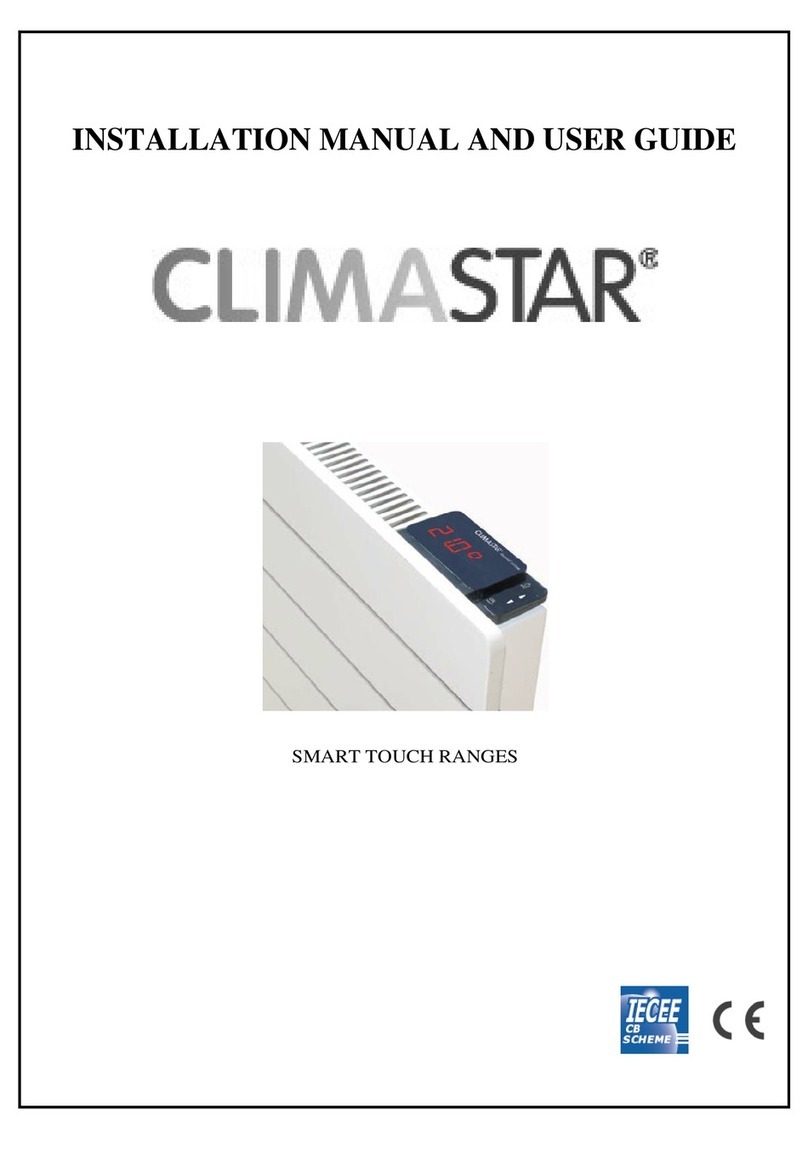
CLIMASTAR
CLIMASTAR SMART TOUCH 500 Installation manual and user's guide

Thermor
Thermor Emotion barres Digital instruction manual

Thermoscreens
Thermoscreens Designer PHV Series Installation, operation and maintenance instructions
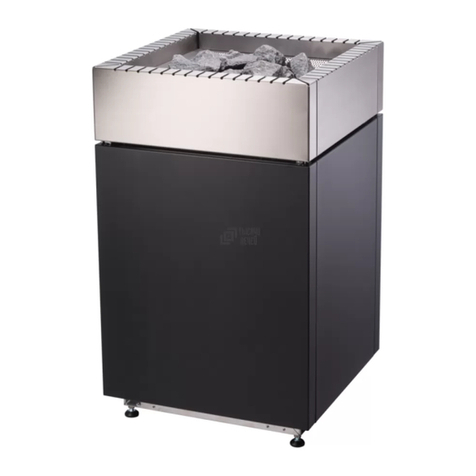
Harvia
Harvia sentiotec Qube Instructions for installation and use
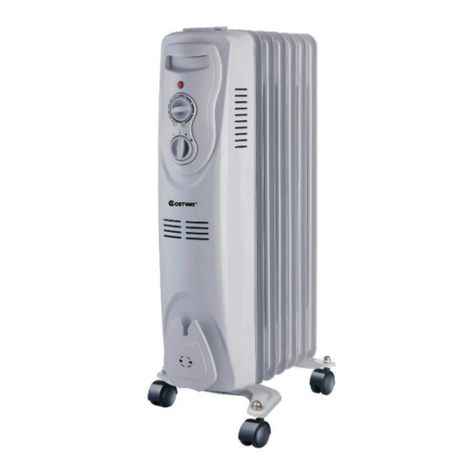
Costway
Costway EP24150 user manual
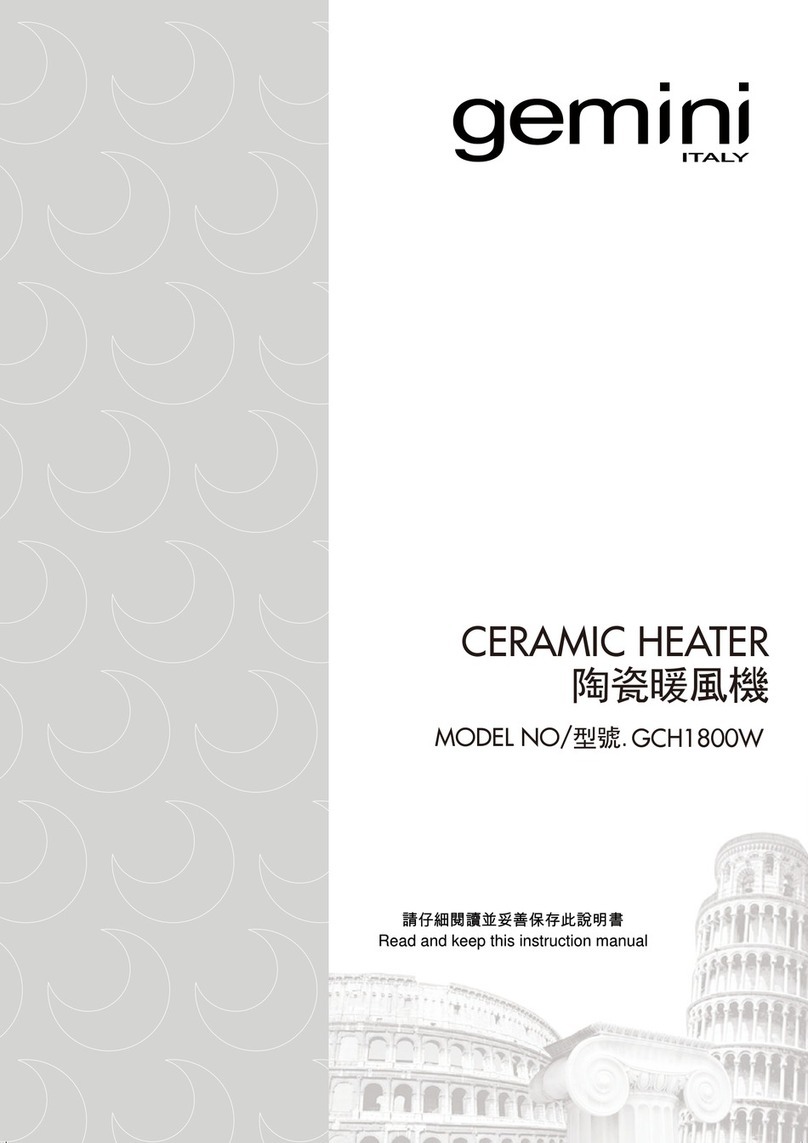
Gemini
Gemini GCH1800W instruction manual
